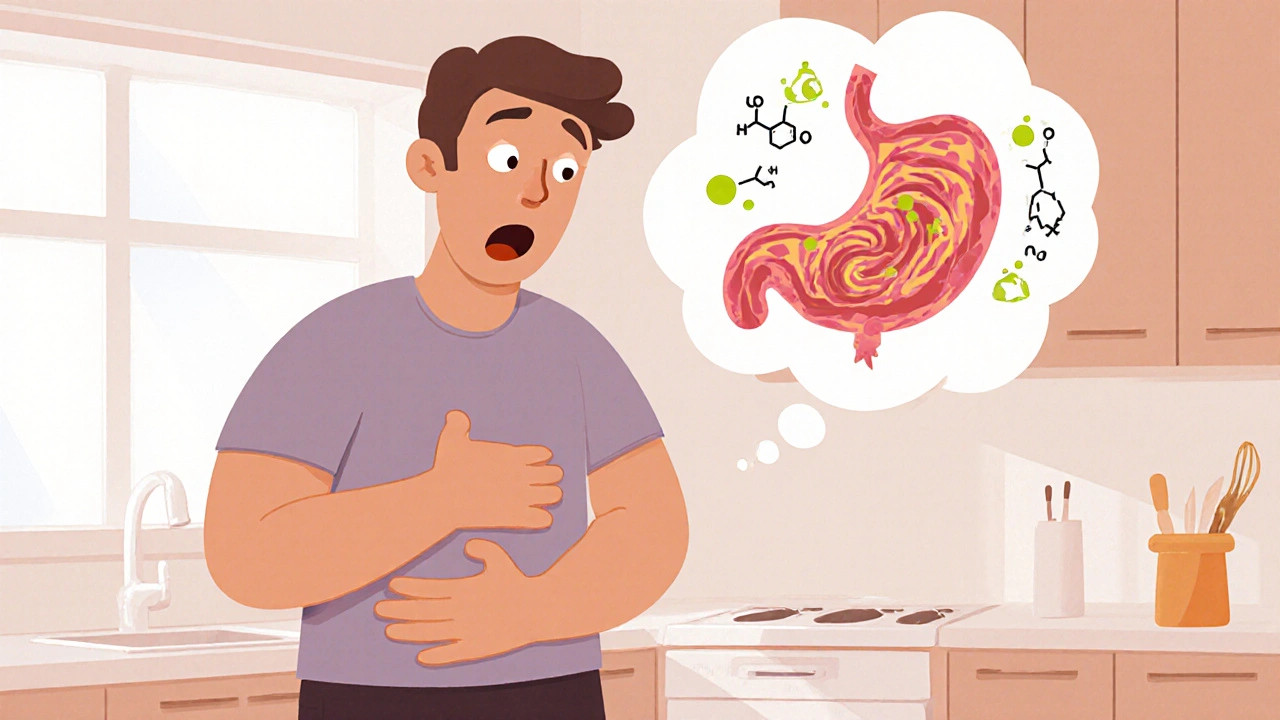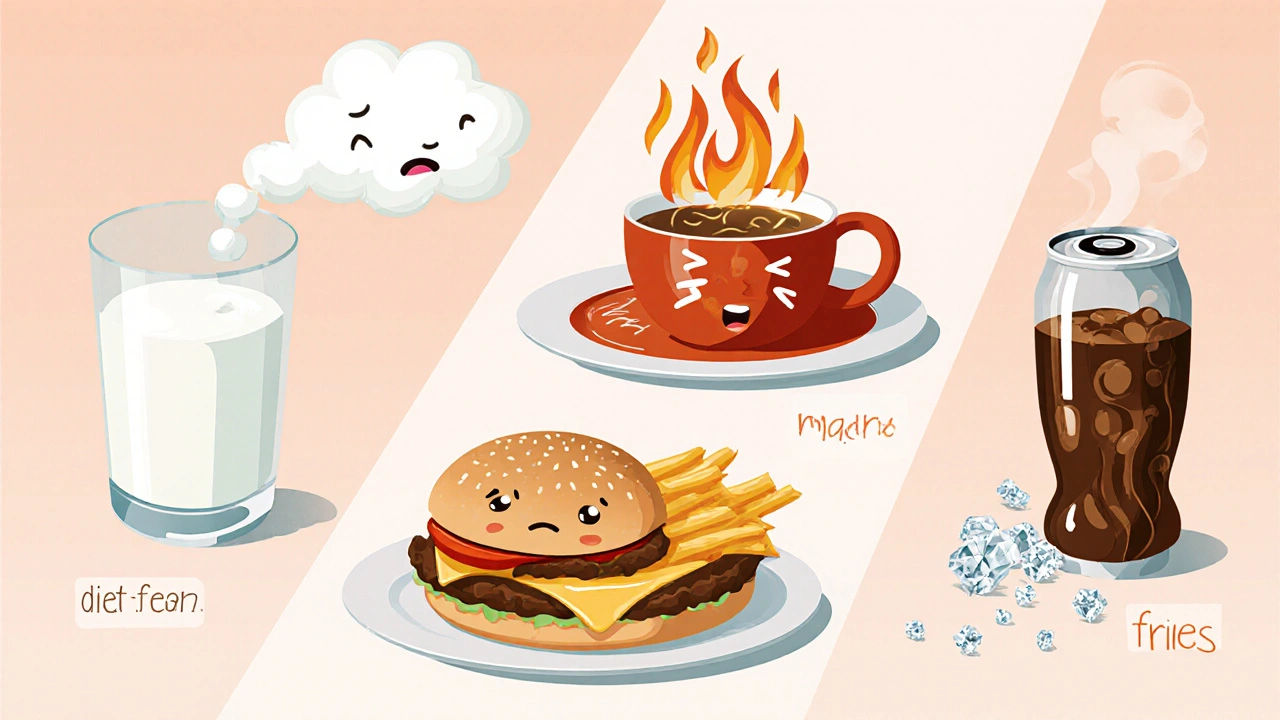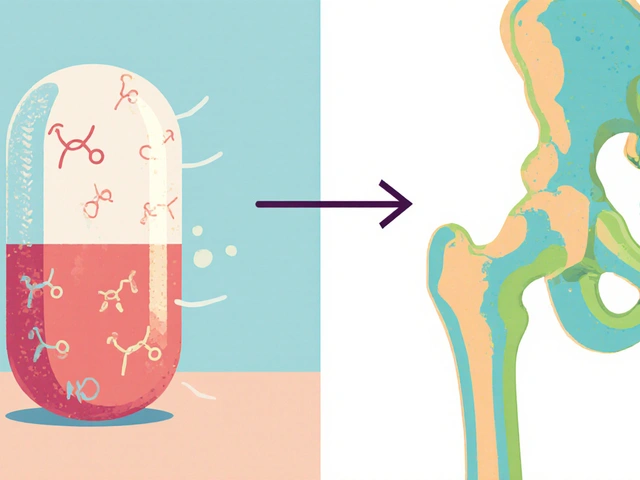
Stomach Comfort Checker
Your Symptoms
Recent Foods
When Upset Stomach refers to any sudden discomfort in the abdomen that often includes pain, nausea, or bloating, the first thing people do is wonder if something they ate is to blame. That gut reaction is normal-our digestive system is highly sensitive to what we put in it. Below you’ll find the five foods most likely to stir up trouble, plus practical ways to spot the culprit and calm the chaos.
How Food Can Irritate Your Digestion
Every bite sets off a chain of chemical signals. Enzymes break down proteins, fats, and carbs, while stomach acid (mainly Gastric acid a hydrochloric solution that helps dissolve food and kill bacteria) creates the right pH for digestion. When a food contains components your body struggles to process-like lactose, excess fat, or certain sweeteners-the gut reacts. The result can be gas, cramping, or that dreaded nausea.
1. Dairy Products and Lactose Intolerance
If you feel a rumble after a glass of milk, cheese, or ice cream, dairy might be the issue. Many adults lack enough Lactose intolerance the inability to fully digest the sugar lactose found in milk. The undigested lactose ferments in the colon, producing gas and pulling water into the intestines, which leads to bloating and watery stools.
Typical signs include:
- Bloating within 30 minutes of dairy intake
- Soft, gassy stools
- Occasional stomach cramps
Switching to lactose‑free milk or hard cheeses (which have less lactose) often resolves the problem.
2. Spicy Foods and Capsaicin
Love a good curry or hot sauce? The compound that gives them heat-Spicy foods foods containing capsaicin, which stimulates receptors in the digestive tract-can also overstimulate the stomach lining. Capsaicin increases acid production, which may cause irritation, especially if your stomach is already sensitive.
Symptoms to watch for:
- Burning sensation in the upper abdomen
- Heightened heartburn
- Occasional nausea after a heavy, spicy meal
If you love the flavor, try milder versions or pair spicy dishes with dairy (yogurt or milk) to buffer the acid.
3. Caffeine‑Rich Drinks
Coffee, black tea, energy drinks, and even some sodas contain Caffeine a stimulant that can increase stomach acid secretion and speed up gut motility. While a moderate amount awakens you, too much can lead to discomfort, especially on an empty stomach.
Common reactions include:
- Sharp stomach pain shortly after drinking
- Increased gas and bloating
- Quick urge to use the bathroom
Try limiting caffeine to one cup a day and always pair it with food.

4. Fatty and Fried Foods
Think burgers, fries, and creamy sauces. High‑fat meals stay longer in the stomach, prompting extra Fatty foods foods rich in saturated or trans fats that slow gastric emptying. This delay can cause a buildup of gastric acid, leading to indigestion and a feeling of fullness.
Typical signs:
- Heavy, bloated feeling after meals
- Acid reflux or heartburn
- Occasional nausea if the meal is very greasy
Choosing grilled instead of fried, or swapping butter for olive oil, can make a big difference.
5. Artificial Sweeteners
Low‑calorie drinks and sugar‑free snacks often use sweeteners like sorbitol, mannitol, or sucralose. These Artificial sweeteners synthetic sugar substitutes that are poorly absorbed in the small intestine can ferment in the colon, producing gas and pulling water into the bowels.
Symptoms you might notice:
- Cramping and gas after a diet soda
- Loose stools or diarrhea
- Feeling bloated for several hours
Switching to natural sweeteners like honey or limiting sweetener‑laden products usually eases the issue.
How to Pinpoint the Real Culprit
Keeping a simple food diary can be a game‑changer. Write down everything you eat and drink, then note any stomach discomfort within the next few hours. After a week, patterns often emerge-maybe you only feel off after coffee, or perhaps dairy is the common denominator.
Another quick test is the elimination‑reintroduction method. Remove the suspected food for 3-5 days, observe any improvement, then re‑introduce it and watch for symptoms returning. This approach works well for dairy, caffeine, and artificial sweeteners.

Immediate Relief Tips
When you’re already feeling uneasy, these strategies can calm the gut without medication:
- Sip warm water or herbal tea (ginger or peppermint) to relax muscles.
- Eat plain, bland foods like bananas, rice, applesauce, and toast (the BRAT diet).
- Avoid lying flat-sit upright for at least an hour after eating.
- Try a small amount of probiotic yogurt if you’re not lactose‑intolerant; good bacteria can aid digestion.
Remember, upset stomach isn’t a reason to panic, but persistent pain warrants a deeper look.
When to Seek Professional Help
Most food‑related discomfort resolves within a day or two. However, watch for red‑flag symptoms that suggest something more serious:
- Severe, constant abdominal pain lasting more than 24 hours.
- Blood in vomit or stool.
- Unexplained weight loss or loss of appetite.
- Fever over 101°F (38.3°C) accompanying stomach pain.
If any of these appear, book an appointment with a GP or gastroenterologist promptly.
Quick Reference Table
| Food Group | Typical Symptom | How to Avoid |
|---|---|---|
| Dairy | Bloating, gas, soft stools | Switch to lactose‑free or low‑lactose options |
| Spicy foods | Burning stomach, heartburn | Use milder spices, pair with dairy |
| Caffeine | Sharp pain, rapid bowel movements | Limit to one cup, drink after meals |
| Fatty foods | Heavy feeling, reflux | Choose grilled, reduce fried items |
| Artificial sweeteners | Gas, diarrhea | Opt for natural sweeteners or limit intake |
Frequently Asked Questions
Can an upset stomach be a sign of a serious condition?
Most of the time it’s just a reaction to food, stress, or a mild virus. However, if you experience severe pain, blood, fever, or persistent vomiting, you should see a doctor right away.
How long does it usually take for symptoms to disappear?
Mild cases often improve within a few hours to a day once the offending food is out of the system. If symptoms linger beyond 48 hours, consider adjusting your diet or consulting a professional.
Is it safe to take over‑the‑counter antacids for an upset stomach?
For occasional heartburn, antacids can provide quick relief. They don’t treat underlying food intolerances, so use them sparingly and focus on diet changes.
What role do probiotics play in preventing upset stomachs?
Probiotics introduce beneficial bacteria that help balance the gut microbiome. Regular consumption of fermented foods or a quality supplement can reduce bloating and improve digestion, especially after antibiotic use.
Can stress cause the same symptoms as food‑related upset stomach?
Yes. Stress releases hormones that can speed up or slow down gut movement, mimicking the effects of caffeine or fatty foods. Managing stress with breathing exercises or short walks often eases the discomfort.
8 Comments
Rajesh Singh
October 18 2025
People need to own up to their dietary choices instead of blaming every latte and taco. It’s a moral failing to ignore the simple truth: moderation is the cornerstone of health. When you overindulge in fatty fast‑food, you’re essentially signing a contract with discomfort. The article could have highlighted personal responsibility rather than sensationalizing triggers. Those who claim they’re victims of “artificial sweeteners” often forget the larger picture of processed food addiction.
Albert Fernàndez Chacón
October 18 2025
I’ve found keeping a food diary works wonders for spotting patterns. When I started noting everything I ate, the connection between late‑night coffee and stomach cramps became obvious. Swapping that brew for herbal tea after dinner helped me sleep better and my gut felt calmer. It’s not about cutting everything out, just being mindful of timing and portion sizes.
Drew Waggoner
October 18 2025
Reflecting on my own experience, the quiet moments after a heavy meal can feel like a slow, relentless tide. The gut’s reaction isn’t just physical; it seeps into the mood, making everything feel heavier. Even without dramatic symptoms, the subtle unease can linger for hours, reminding you that the body is always listening. Awareness, not panic, is the key to navigating these waves.
Mike Hamilton
October 18 2025
When we examine the notion of “food triggers,” we quickly realize that the human digestive system is not a static machine but a dynamic ecosystem intertwined with culture, psychology, and environment. Historically, societies have adapted their cuisines to the local flora and fauna, developing fermentations and cooking methods that mitigate potential irritants. In contemporary Western diets, however, the rapid rise of ultra‑processed foods has introduced novel compounds-such as certain artificial sweeteners-that our microbiota have not co‑evolved with, leading to dysbiosis and gastrointestinal distress. Moreover, stress, an often‑overlooked variable, modulates gut motility through the brain‑gut axis, amplifying the impact of even benign foods. Therefore, labeling a single ingredient as a villain oversimplifies a multifaceted interaction. A balanced approach, incorporating mindful eating, diversified fiber sources, and occasional fasting, can restore homeostasis. Embracing traditional dietary wisdom, like the Mediterranean emphasis on whole grains and olive oil, provides a resilient framework against modern irritants. Additionally, fostering a diverse gut microbiome through fermented foods-yogurt, kimchi, kombucha-offers a natural buffer to occasional lapses. Remember that the gut’s response is a dialogue, not a monologue; it signals when something is amiss, and we must listen with curiosity rather than fear. In practice, a simple experiment-removing a suspected trigger for a week and reintroducing it-often clarifies the true culprit. Ultimately, the goal is not to live in fear of food but to cultivate a harmonious relationship where nourishment supports both body and mind.
Matthew Miller
October 19 2025
What a fantastic deep‑dive! Your philosophical take reminds us that food is more than fuel-it’s a cultural narrative. I’m pumped to try swapping out sugary snacks for some fermented goodies and see how my gut reacts. Let’s keep the conversation alive and empower each other to make smarter choices!
Liberty Moneybomb
October 19 2025
Everyone’s busy preaching about “moderation” while the real agenda is hidden: big food corporations want us to stay addicted to their engineered additives, keeping us compliant and docile. The article cleverly disguises a marketing play, nudging us toward “natural” alternatives that are themselves curated by the same elite. Wake up, folks, before they redesign our stomachs again!
Alex Lineses
October 19 2025
Supporting mindful diet changes fosters community health and resilience.






Tracy O'Keeffe
October 18 2025
Honestly, this whole "five foods" list is just culinary melodrama wrapped in a pseudo‑scientific brochure. Everyone pretends they’re a gut‑guru while sipping their overpriced kombucha, but the truth is most of these triggers are overhyped. Dairy? Sure, some folks have lactose issues, but the average adult can handle a splash of milk without a catastrophe. Spicy food lovers are painted as villains, yet capsaicin also boosts metabolism – a hidden superpower. And let’s not forget that caffeine is practically a vitamin for the modern hustle, not a demon of digestion. If you read past the buzzwords, you’ll see it’s mostly marketing fluff.